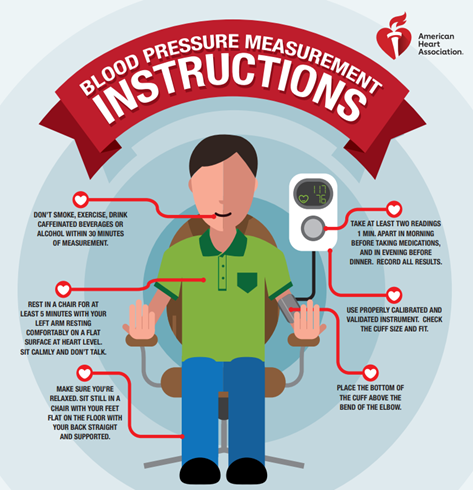Controlling Your Blood Pressure
According to the CDC, nearly half of all adults have high blood pressure, also known as hypertension, and approximately 1 in 3 adults, who have hypertension, are not even aware they have it. Often symptoms of hypertension go unnoticed and without treatment, the likelihood of developing heart disease or having a stroke increases. The best prevention is knowing your numbers and taking action to control your blood pressure and protect your heart.
Know Your Numbers – What do your blood pressure numbers mean?
The only way to know if you have high blood pressure is to have your blood pressure checked. Learn what your blood pressure numbers mean to you and your health.
Take the pledge to controlling your blood pressure!
| Blood Pressure Category | Systolic mm Hg (upper number) | and/or | Diastolic mm Hg (lower number) |
|---|---|---|---|
| Normal | Less than 120 | and | Less than 80 |
| Elevated | 120-129 | and | Less than 80 |
| High Blood Pressure (Hypertension) Stage 1 | 130-139 | or | 80-89 |
| High Blood Pressure (Hypertension) Stage 2 | 140 or higher | or | 90 or higher |
| Hypertensive Crisis (consult your doctor mmediately) | Higher than 180 | and/or | Higher than 120 |
Working together with your doctor to manage high blood pressure
- Ask about your blood pressure at your annual checkup. If you have high blood pressure, talk to your doctor about steps to take to control of your blood pressure to lower your risk for heart disease and stroke. Regularly check it between appointments either at home or at a pharmacy with a blood pressure monitor.
- Track your blood pressure readings. Keep a log of your blood pressure levels (PDF) and questions to ask your doctor (PDF).
Self-Monitor Your Blood Pressure Regularly
Learn how to correctly monitor your blood pressure at home to help keep you in a healthy range. Remember to follow the advice of your doctor or other health care professional.

Self-Measured Blood Pressure Monitoring
What you need to know
Video: Self-Measured Blood Pressure Monitoring
(duration 3:46)
Helpful Tips to Self-Monitoring Blood Pressure
- Be still. Don't smoke, drink caffeinated beverages or exercise within 30 minutes before measuring your blood pressure. Empty your bladder and ensure at least 5 minutes of quiet rest before measurements.
- Sit correctly. Sit with your back straight and supported (on a dining chair, rather than a sofa). Your feet should be flat on the floor and your legs should not be crossed.
- Measure at the same time every day. It’s important to take the readings at the same time each day, such as morning and evening.
- Take multiple readings and record the results. Each time you measure, take at least two readings one minute apart and record blood pressure levels (PDF). If your monitor has built-in memory to store your readings, take it with you to your appointments.
Lifestyle Changes You Can Make To Manage Your Blood Pressure
- Enjoy regular physical activity
- Eat a well-balanced diet that’s low in salt
- Manage stress
- Maintain a healthy weight
- Limit alcohol
- Quit smoking
- Take your medications properly

